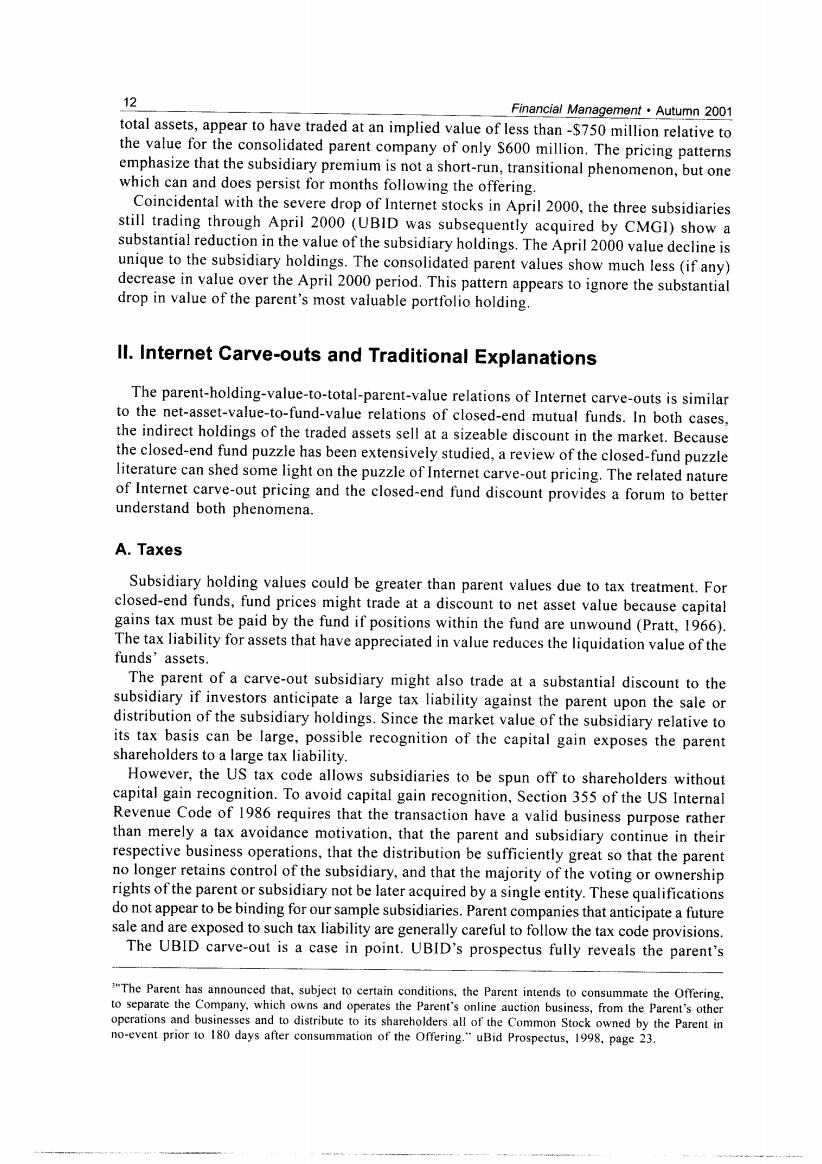正在加载图片...

12 Financial Management Autumn 2001 total assets,appear to have traded at an implied value of less than-$750 million relative to the value for the consolidated parent company of only S600 million.The pricing patterns emphasize that the subsidiary premium is not a short-run,transitional phenomenon,but one which can and does persist for months following the offering. Coincidental with the severe drop of Internet stocks in April 2000,the three subsidiaries still trading through April 2000(UBID was subsequently acquired by CMGI)show a substantial reduction in the value of the subsidiary holdings.The April 2000 value decline is unique to the subsidiary holdings.The consolidated parent values show much less (if any) decrease in value over the April 2000 period.This pattern appears to ignore the substantial drop in value of the parent's most valuable portfolio holding Il.Internet Carve-outs and Traditional Explanations The parent-holding-value-to-total-parent-value relations of Internet carve-outs is similar to the net-asset-value-to-fund-value relations of closed-end mutual funds.In both cases, the indirect holdings of the traded assets sell at a sizeable discount in the market.Because the closed-end fund puzzle has been extensively studied,a review of the closed-fund puzzle literature can shed some light on the puzzle of Internet carve-out pricing.The related nature of Internet carve-out pricing and the closed-end fund discount provides a forum to better understand both phenomena. A.Taxes Subsidiary holding values could be greater than parent values due to tax treatment.For closed-end funds,fund prices might trade at a discount to net asset value because capital gains tax must be paid by the fund if positions within the fund are unwound(Pratt,1966). The tax liability for assets that have appreciated in value reduces the liquidation value of the funds'assets. The parent of a carve-out subsidiary might also trade at a substantial discount to the subsidiary if investors anticipate a large tax liability against the parent upon the sale or distribution of the subsidiary holdings.Since the market value of the subsidiary relative to its tax basis can be large,possible recognition of the capital gain exposes the parent shareholders to a large tax liability. However,the US tax code allows subsidiaries to be spun off to shareholders without capital gain recognition.To avoid capital gain recognition,Section 355 of the US Internal Revenue Code of 1986 requires that the transaction have a valid business purpose rather than merely a tax avoidance motivation,that the parent and subsidiary continue in their respective business operations,that the distribution be sufficiently great so that the parent no longer retains control of the subsidiary,and that the majority of the voting or ownership rights of the parent or subsidiary not be later acquired by a single entity.These qualifications do not appear to be binding for our sample subsidiaries.Parent companies that anticipate a future sale and are exposed to such tax liability are generally careful to follow the tax code provisions. The UBID carve-out is a case in point.UBID's prospectus fully reveals the parent's "The Parent has announced that,subject to certain conditions,the Parent intends to consummate the Offering. to separatc the Company.which owns and operates the Parent's online auction business,from the Parent's other operations and businesses and to distribute to its shareholders all of the Common Stock owned by the Parent in no-event prior to 180 days after consummation of the Offering."uBid Prospectus,1998,page 23